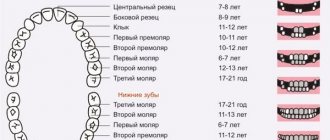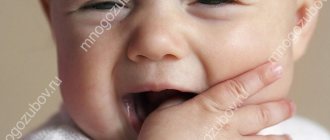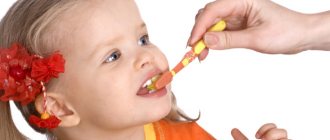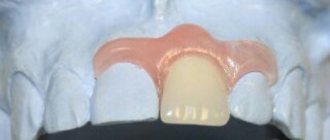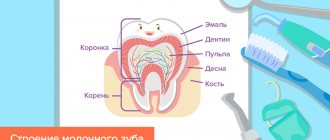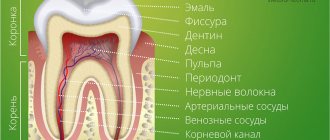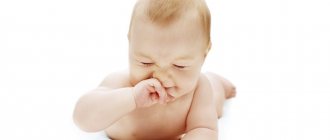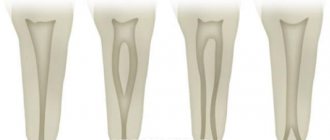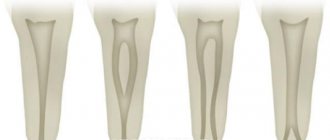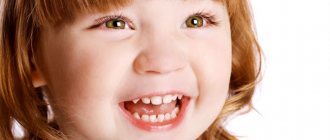The children's relatives rejoice at the little one's new skills. The appearance of his baby teeth causes special trepidation. There are many signs associated with the first tooth that you should not pay attention to. For example, if a tooth comes out not just one, but next to the next one, then the baby will grow up to be cruel and bloodthirsty. Another sign, the interpretation of which raises questions - if a tooth erupts on the upper gum, then this means the baby will soon die. However, there are also interpretations that often come true.
"Schedule" of teething in children
6-8 months: 4 front incisor teeth, two central ones on each jaw; The lower central incisors appear first, then the upper central ones; These teeth erupt in pairs and come into contact with each other, forming a certain bite height. At this time, the baby can already process slightly hard foods with his first teeth.
8-12 months: 4 lateral incisors, two on the lower jaw, then two on the upper.
16-20 months : 4 canines, two on each jaw. Children's dentists and pediatricians consider the eruption of these teeth to be the most difficult - both in terms of the anatomy of the tooth and its location. Fangs make it possible to bite off “adult” hard food, but the baby cannot chew it yet.
20-30 months: 8 molars (large molars), 4 on each jaw. It is the molars that will allow the baby to chew bitten off solid food.
Thus, by the age of three (for some, by two and a half), the child has 20 milk teeth.
Baby teething chart
How to protect the first baby teeth from caries?
Despite the fact that the child’s baby teeth will be replaced by molars, they should be provided with proper care and protected from caries. Thanks to daily hygiene procedures for oral care, you can accustom your baby to cleanliness and avoid numerous health problems. Those parents who believe that baby teeth should not be cared for as they will fall out anyway are wrong. After all, the point is not only in the development of caries, but also in the formation of a correct bite and facial skeleton in the baby.
To prevent the development of caries in a child, you need to follow the following recommendations:
- Brush baby teeth with a special finger brush for children;
- Do not lick the baby’s nipple and do not eat food from his spoon, so as not to introduce foreign microorganisms into the baby’s oral cavity;
- Give the child a few sips of water after eating, and when the little one grows up, he should be taught to rinse his mouth after eating;
- Reduce the amount of sweets in the child’s diet to a minimum;
- Make sure that calcium and vitamin D are present in his diet, since these beneficial substances “work” only in pairs;
- Try to prevent situations in which the baby can damage his teeth. If the enamel is destroyed, the damaged tooth will be more quickly affected by caries.
Parents should remember that the health of molars is directly proportional to the health of baby teeth, so they need to be carefully monitored and properly cared for.
Teeth are out of time: why are they “in a hurry” or delayed?
The diagram shows the average time for the appearance of baby teeth, but for some babies they may erupt a couple of months earlier, for others later. Experts consider a deviation of 1-2 months to be the norm, because the timing of the appearance of the first teeth can be influenced not only by the menu of the mother and child, but also by heredity and even the season of birth of the baby (those born in spring and winter have teeth earlier than summer and autumn babies).
A deviation from the norm is either the complete absence of teeth in a one-year-old child, or their early eruption at the age of 2-3 months, or the birth of a child with teeth. In this case, the baby must be shown to a pediatrician, endocrinologist and dentist, who will promptly notice the possible development of rickets or endocrine disease. The “schedule” of teething is also important, so parents should pay attention to the sequence of appearance of baby teeth according to the natural pattern laid down by nature.
Why do they give a silver spoon for the first tooth?
Folk customs
Our ancestors believed that silver attracts goodness and prosperity, protects against damage, the evil eye, and conspiracy. A spoon made of this metal was placed in a child’s crib as a talisman against evil spirits. Although such a custom has nothing to do with the Orthodox faith, some still remain superstitious today and follow the traditions of their grandparents.
Useful properties of silver
| After the first tooth appears, the baby can begin to introduce complementary foods using a silver spoon. This metal has antibacterial and antimicrobial properties. Most pathogenic microorganisms, including E. coli, streptococcus, and staphylococcus, known for their toxic effects, die on its surface. Silver ions from the surface of the dishes penetrate into water and food, thereby disinfecting the contents. At the same time, the products are saturated with particles of noble metal, which, when ingested, fight toxins, improve metabolic processes, and increase the body's resistance to colds. In addition, when feeding a child with a silver spoon, the microbes in the mouth also die. |
Who gives the silver spoon
Previously, only godparents could give a silver spoon to a child at a christening. It was cherished as a symbol of the emerging spiritual kinship, kept as a family heirloom and passed on by inheritance.
Today, a silver spoon for the first tooth is given not only by godparents, but also by relatives and family friends. In addition, it may not be one spoon, but, for example, a set of spoons and forks, rattles or cups.
What can affect the timing of teething?
- hereditary factors (if the parents’ eruption pattern was disrupted);
- maternal smoking and other bad habits;
- diseases suffered during pregnancy, as well as chronic diseases of the mother and father;
- timing of the birth of the child (prematurity, late birth);
- the course of the birth process;
- ARVI and other diseases that the child suffered during the first months of life;
- method of feeding (breast or artificial).
How can you tell if your baby is teething?
Teething in children, symptoms:
Capricious behavior is associated with the movement of the tooth through the gum: this causes pain and itching. The baby tries to scratch his gums with any means at hand, bites, and gets nervous. Help your child relieve unpleasant symptoms by purchasing a special teether.
Deterioration of appetite and even refusal of food (especially if it is hot). After taking the breast, the baby may try to bite the nipple. Help your baby by massaging his gums a little before feeding.
Unusual drowsiness, fatigue, increased body temperature, excessive salivation. Normally, a child’s temperature during teething should not be higher than 37.5-38 degrees, and a higher temperature indicates other problems not related to teeth. The reason for the increase in temperature is inflammation of the gums, and abundant saliva creates a protective barrier against infections, performing a bactericidal and anti-inflammatory function. How long does the temperature last during teething? No more than 3-4 days, without a sharp increase in temperature to high levels.
Weakening of stool (stool acquires the consistency of “soft porridge” without changing its usual color), as well as a slight increase in frequency.
However, children should not have diarrhea during teething; this is an alarming symptom.
Parents need to know:
If a child’s temperature rises above 38 degrees, and is accompanied by diarrhea, vomiting, impaired consciousness and a rash, such symptoms are not at all associated with teething, but signal the presence of an infection. With such symptoms, it is necessary to urgently call an ambulance or show the child to a pediatrician.
Signs of imminent teething
The main sign of the imminent appearance of teeth is increased salivation, but it should be remembered that this statement is not 100% true in all cases. At the age of 3 months, all babies' salivary glands begin to actively work, but this does not mean that teeth will appear soon.
Many parents notice that their children’s mood deteriorates, they become more capricious and irritable, and pain and discomfort are to blame. If a child has a strong immune system, then, as a rule, there are no other signs, and the process itself proceeds quite quickly and with minimal inconvenience.
Additional signs of teething include:
- Temperature increase;
- Stomach upset;
- Cough due to increased amount of saliva;
- Runny nose.
A couple of days before teeth begin to erupt, you may notice slight redness of the gums and
swelling, a whitish tubercle will begin to stand out, and the incisor itself can be easily tapped with an ordinary spoon.
How to help your baby with teething
Expert Tips:
Many mothers panic: “The child is teething, how can I relieve the pain?” They can be understood, because even a little pain in a baby is difficult for a mother to experience. However, it is important to be patient and not to overdo it when providing assistance, and to know that medications are not prescribed for teething. Only symptomatic help is possible: antipyretic drugs and drinking plenty of fluids at a fever, using painkillers - paracetamol or ibuprofen, ventilating the baby's room and maintaining a cool temperature in it, instilling a solution of sea salt into the nose, as well as using a special gel during teething in infants. Teethers that can be cooled a little before giving to the baby are good helpers. Some of them contain cooling gel inside.
Parents should also know about popular myths associated with baby teething:
- “when teeth are cut, immunity decreases”: this is not true, immunodeficiency does not occur during teething;
- “the child needs to endure the teething situation”: it is not at all necessary to expose the baby to stress, which disrupts his sleep and ability to eat normally. If a teether or gel does not help, it is more humane to give the baby ibuprofen than to force him to endure experiences he does not understand;
- “if the gums are swollen, it means teeth will appear soon”: this is not true, the appearance of the gums does not at all indicate the timing of teething.
- “When the teeth erupt, the rash (skin itching, redness, etc.) will go away on its own”: some infant pathologies (for example, atopic dermatitis) may coincide in time with the appearance of teeth, but these diseases require treatment, and not waiting for it that “everything will resolve itself.”
- “Vaccinations during teething are contraindicated”: this is not true, since a decrease in immunity does not occur during teething.
- “when teeth are cutting, it is better not to introduce new complementary foods”: this is not true, there is no reason for restrictions.
- “until all the teeth have completely erupted, there is no need to brush them”: this is not true, brushing your teeth should begin when the incisors erupt.
- “with the eruption of the first teeth, it is necessary to abandon night feedings, otherwise they will cause caries”: this is a myth, since breastfeeding (neither day nor night) has nothing to do with the occurrence of caries.
The influence of the future mother's health on her child's teeth
So that your baby can be proud of a white-toothed smile, it is advisable for you to take care of this already at the stage of pregnancy. Surprisingly, this is a proven fact: the color, strength and health of teeth can be influenced by severe toxicosis of the mother and the diseases she suffered in the first trimester.
Try to protect yourself as much as possible from stress and unusual situations, follow the classic recommendations about the benefits of fresh air and proper nutrition, and do not forget about special complex vitamins for expectant mothers.
During pregnancy, you should refrain from using medications; if absolutely necessary, you should consult your doctor and refer to the list of approved medications. It is strictly not recommended to use antibiotics with tetracycline. This drug leads to the fact that children's teeth will then be maximally depleted, contain almost no enamel, and have an unpleasant grayish color.
Remember that during pregnancy it is also necessary to take care of the health of the mother’s teeth. It is advisable to visit the dentist at the stage of pregnancy planning and carry out all medical measures, also follow the correct diet, do not forget about additional vitamin complexes and carefully carry out hygiene procedures.
The determining factor in your child’s dental health, as we have already found out, is heredity. Find out if among your relatives there are people with really neglected teeth; if this situation occurs, then preventive measures should be strengthened many times over. First of all, the baby will need to be taken to the dentist more often, ensure daily brushing of teeth, select special mouth rinses, and adjust the diet.
